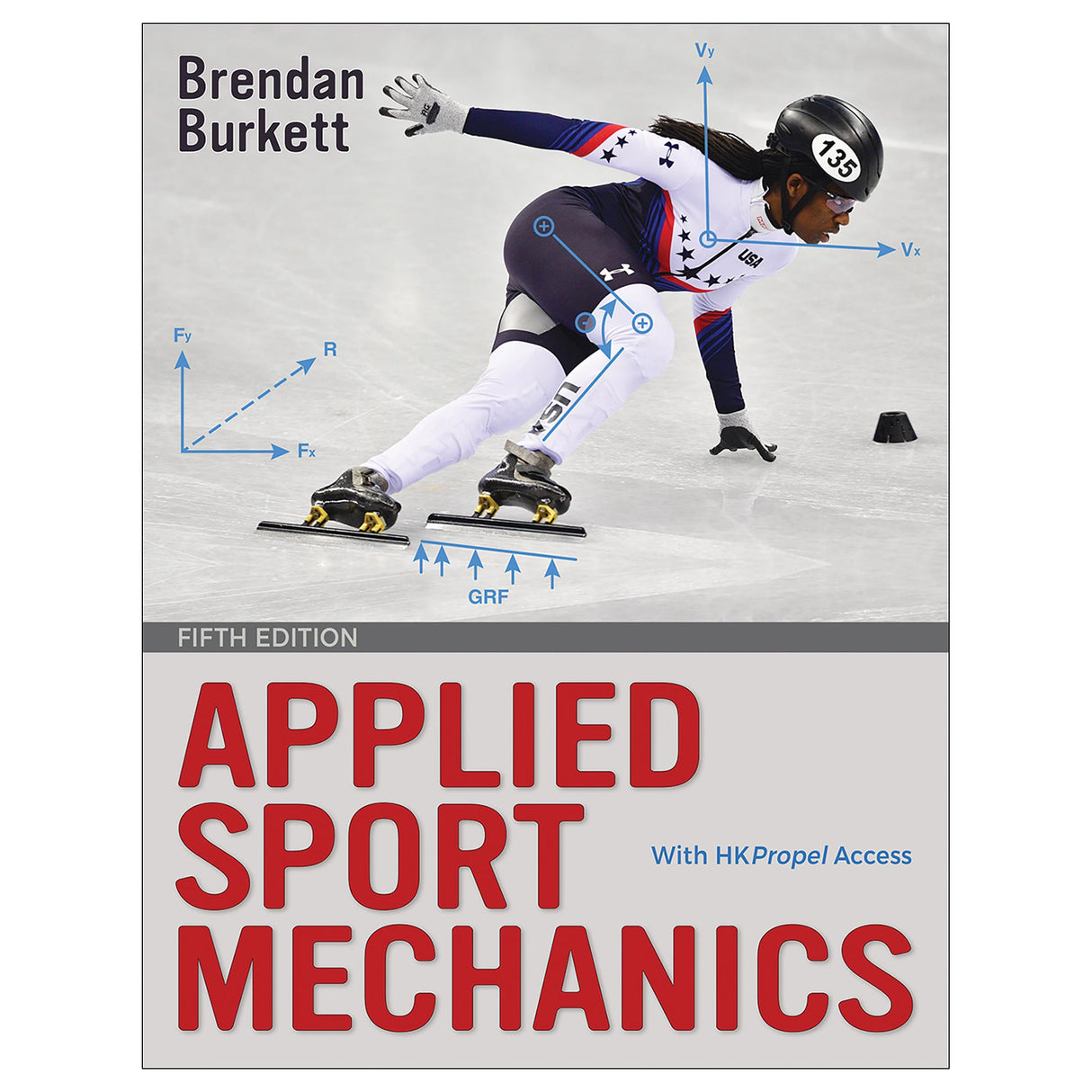Applied Sport Mechanics 5th Edition Ebook With HKPropel Access
Author: Brendan Burkett
$94.95 CAD

Unlock the secrets of athletic performance with Applied Sport Mechanics, Fifth Edition With HKPropel Access. This comprehensive guide is designed to help students, coaches, and physical educators understand the fundamental laws of human movement and their impact on sport performance. Authored by Brendan Burkett, PhD, a renowned expert in biomechanics and sport coaching, this edition offers a unique blend of theory and practical application. Throughout the full-color text, photos and illustrations offer visual demonstrations of the content to engage readers and clarify complex topics.
Key features include these:
- Application to Sport sidebars that connect concepts directly to sport performance and analysis
- Pedagogical aids, including a glossary and chapter objectives, to facilitate learning and comprehension
- Related online resources delivered through HKPropel, featuring a study guide, chapter review questions, practical activities, and author recommendations of videos and blogs for further learning
Endorsed by SHAPE America, the updated fifth edition includes expanded information on new technologies and their use in biomechanical assessment and training. Instead of focusing on a few popular sports, Burkett explores mechanics across a range of sport skills—including sprinting, jumping, swimming, lifting, throwing, and kicking—and highlights applications across a diverse variety of sports, such as rugby, cycling, golf, swimming, and javelin throwing.
Whether you're a student in biomechanics or a professional looking to enhance your understanding of sport performance, Applied Sport Mechanics, Fifth Edition, is your go-to resource for mastering the mechanics of sport.
Note: A code for accessing HKPropel is included with this ebook.
Audience
An introductory textbook for undergraduate courses in biomechanics and sport mechanics in kinesiology. Also a reference for coaches and physical educators.Chapter 1. Introduction to Applied Sport Mechanics
How Applied Sport Mechanics Is Organized
What Is Sport Mechanics?
Understanding and Quantifying Technique
Summary
Key Terms
References
Chapter 2. Anatomical Requirements for Sport
Standard Anatomical Reference Terminology
Connection Between Human Anatomy and Sport Mechanics
Summary
Key Terms
References
Chapter 3. Fundamentals of Sport Mechanics
How to Describe Human Motion
Applying Sport Mechanics to Resistance Training
Measurement and Evaluation in Sport Mechanics
Summary
Key Terms
References
Chapter 4. Fundamentals of Sport Kinetics
Work
Power
Energy
Rebound
Friction
Summary
Key Terms
References
Part II. Applications in Sport
Chapter 5. Linear Motion
Linear Motion Measures (Speed, Velocity, and Acceleration)
Linear Motion for Projectiles
Summary
Key Terms
References
Chapter 6. Linear Kinetics
Fundamental Principles of Linear Kinetics
Momentum and Impulse in Sport
How to Measure Linear Kinetics: Running Gait
Summary
Key Terms
References
Chapter 7. Angular Motion
Fundamental Principles of Angular Motion
Applied Angular Motion: How an Athlete Initiates Rotation
Summary
Key Terms
References
Chapter 8. Angular Kinetics
Gravity: Fundamental Principle of Angular Kinetics
Angular Momentum
Summary
Key Terms
References
Chapter 9. Stability and Instability
Fundamental Principles for Stability
Mechanical Principles for Stability
Factors That Increase Stability
How to Measure Center of Gravity and Line of Gravity for an Athlete
Summary
Key Terms
References
Chapter 10. Moving Through Fluids
Fundamental Principles of Moving Through Fluids
Hydrostatic Pressure and Buoyancy
Drag and Lift
Factors That Influence Moving Through Air and Water
Summary
Key Terms
References
Part III. Putting Your Knowledge of Sport Mechanics to Work
Chapter 11. Analyzing Sport Skills
Step 1: Determine the Objectives of the Skill
Step 2: Note Any Special Characteristics of the Skill
Step 3: Study Top-Flight Performances of the Skill
Step 4: Divide the Skill Into Phases
Step 5: Divide Each Phase Into Key Elements
Step 6: Understand the Mechanical Reasons That Each Key Element Is Performed as It Is
Summary
Key Terms
References
Chapter 12. Identifying and Correcting Errors in Sport Skills
Step 1: Observe the Complete Skill
Step 2: Analyze Each Phase and Its Key Elements
Step 3: Use Your Knowledge of Sport Mechanics in Your Analysis
Step 4: Select Errors to Be Corrected
Step 5: Decide on Appropriate Methods for the Correction of Errors
Summary
Key Terms
References
Chapter 13. Optimizing Sport Mechanics
Sprinting
Jumping
Wheelchair Sports
Throwing
Striking and Batting
Swinging and Rotating
Weightlifting
Combat Throwing
Tackle in Football
Swimming
Kicking a Ball
Paddling a Watercraft
Summary
References
Appendix. Units of Measurement and Conversions
Endorsed by SHAPE America
SHAPE America is endorsing the textbook Applied Sport Mechanics, Fifth Edition, by Brendan Burkett for use in the Physical Educators curriculum. This comprehensive resource is an invaluable asset for physical educators, providing a robust foundation in sport mechanics and practical applications that enhance teaching and coaching effectiveness.
Part I: Foundations of Sport Mechanics offers a thorough overview of how sport and anatomy relate to physical education content. Chapters such as Introduction to Applied Sport Mechanics, Anatomical Requirements for Sport, Sport Mechanics Fundamentals, and Fundamentals of Sport Kinetics equip educators with essential knowledge to understand the interplay between anatomy and sport mechanics.
Part II: Applications in Sport delves into specific sport skills and activities relevant to physical education. Chapters on Linear Motion, Linear Kinetics, Angular Motion, Angular Kinetics, Stability and Instability, and Moving Through Fluids provide detailed discussions on various motion types and their implications for sport skills.
Part III: Putting Your Knowledge of Sport Mechanics to Work is where the textbook truly shines for teachers and coaches. Chapters like Analyzing Sport Skills, Identifying and Correcting Errors in Sport Skills, and Optimizing Sport Mechanics offer practical guidance on breaking down individual skills, providing specific feedback, and improving students' efficiency of movements. These chapters emphasize the importance of understanding the phases of sport skills and prioritizing feedback to avoid overwhelming students and ensure effective skill development.
Overall, Applied Sport Mechanics is a comprehensive resource for physical educators seeking to deepen their understanding of sport mechanics and apply this knowledge to enhance their teaching and coaching practices.
How is power used in athletic contests?
How to observe a skill
 Momentum and kinetic energy in a tackle
Momentum and kinetic energy in a tackle Radius of gyration
Radius of gyration Rotary stability examples
Rotary stability examples Moving through fluids
Moving through fluids
All ancillaries are free to adopting instructors through HKPropel.
Instructor guide. Includes a sample syllabus, suggested learning activities, and lecture aids. Each chapter in the instructor guide also include practical activity questions, written with application in mind to practice skills necessary for biomechanical analysis.
Test package. Contains 255 questions in true-false, fill-in-the-blank, essay and short-answer, and multiple-choice formats. The files may be downloaded for integration with a learning management system or printed for use as paper-based tests. Instructors may also create their own customized quizzes or tests from the test bank questions to assign to students directly through HKPropel. Multiple-choice and true-false questions are automatically graded, and instructors can review student scores in the platform.
Chapter quizzes. Contains ready-made quizzes (9-10 questions each) to assess student comprehension of the most important concepts in each chapter. Each quiz may be downloaded or assigned to students directly through HKPropel. The chapter assessments are automatically graded, and instructors can review student scores in the platform.
Presentation package. Features more than 290 PowerPoint slides of text, artwork, and tables from the book that can be used for class discussion and presentation. The slides in the presentation package can be used directly within PowerPoint or printed to make handouts for students. Instructors can easily add, modify, and rearrange the order of the slides.
Image bank. Includes most of the figures, content photos, and tables from the text, sorted by chapter. These can be used in developing a customized presentation based on specific course requirements.
Instructors also receive access to all student materials in HKPropel. For Applied Sport Mechanics, Fifth Edition, this includes a study guide, chapter review questions, practical learning activities, and author recommendations of videos and blogs for further learning.





